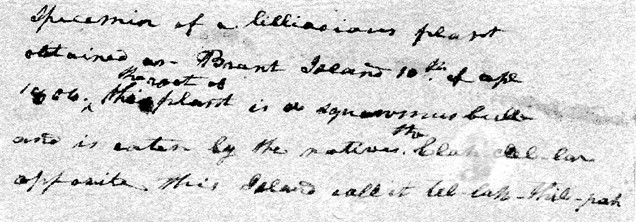|
Botanical Discoveries: Chocolate Lily, Checker Lily, Mission Bells,
Rice Root (Fritillaria lanceolata (aka affinis)
Cascades of the Columbia River in Hood River County, Oregon, April
10, 1806
Known by both Fritillaria lanceolata and Fritillaria affinis, this
northwest native plant is a lily of rare beauty. A handwritten Lewis label
on one specimen (see below) states he collected this species on 10 Apr 1806
as the party worked their canoes up the rapids around Bradford (then
"Bryant") Island, Multnomah Co., Oregon, in the Columbia River. It
is interesting to speculate on the scene that Lewis must have presented,
carefully collecting this checker lily while others labored to pull boats up
stream through cascading waters.
Lewis wrote: Specemin of a lilliacious plant obtained on Brant Island
10th of apl 1806. the root of this plant is a squawmus bulb and is eaten by
the natives. the Clah-clel-lar opposite this Island call it tel-lak-thil-pah.
Pursh's notation added later: Brand island Aprl. 10, 1806. Bulb
squamous, eaten by the natives, who call it tel-lak-thil-pah.
Captain Lewis' note:
 |

Lewis' specimen collected this
day |

Photo by Franco Folini |
|
|
The Expedition's Journey
Continues:
The expedition had only 4 canoes left which was not enough space for the
goods, making the journey more hazardous than necessary. Several members
set about getting more canoes, more horses and other items for the next
leg of their trip. Others were put to work making pack saddles and putting
the equipment to the ready.
". . . found Captain Lewis at camp with
two canoes which he had purchased at a village for two robes and four
elk skins. He also purchased four paddles and three dogs from the
natives, with deer skins. The dogs now constitute a considerable part of
our subsistence, and with most of the party has become a favorable
food. Certain I am that it is a healthy, strong diet."
Captain Clark, 13 April 1806
Although negotiations with the various native
groups eventually gave good enough results that the expedition could
survive, they were sometimes tricky to conclude.
I rose early after a bad night's rest, and
took my merchandise to a rock which afforded an eligible situation for
my purpose and divided the articles of merchandise into parcels of such
articles as I thought best calculated to please the Indians. And in each
parcel I put as many articles as we could afford to give, and thus
exposed them to view, informing the Indians that each parcel was
intended for a horse.
They tantalized me the greater part of the
day, saying that they had sent out for their horses and would trade as
soon as they came. Several parcels of merchandise were laid by for which
they told me they would bring horses. I made a bargain with the chief
for two horses. About an hour after, he canceled the bargain, and we
again bargained for three horses, which were brought forward. Only one
of the three could be possibly used, the other two had such intolerable
backs as to render them entirely unfit for service. I refused to take
two of them, which displeased him, and he refused to part with the
third. . . " Captain Clark, 17 April 1806
On April 18, 1806, the native peoples caught the
first salmon of the season. This was cause for true celebration, as the
harbinger of good things to come. This first fish was dressed, divided
into small pieces and each child in the village was given a portion. The
custom of sharing the first fish was believed to hasten the arrival of the
salmon. Such a welcome addition to the diet of the native peoples as well
as the expedition was undoubtedly a delicious event!
Go to our Corps of Discovery Expedition
Bicentennial Index page
to see all links in this series. Or click
here
to go directly to the next installment of our
journey.
|
 |
|
Bringing
history alive: |
| Cowlitz County
Historical Museum View
Cowlitz Indian cultural artifacts displayed at this museum
that honors the cultural heritage of the people of the Lower
Columbia Region off Interstate 5 in Kelso, Washington.
www.co.cowlitz.wa.us/museum/ |
 |
 |
Ecola State Park
One of Ecola State
Park's first attractions was a beached whale. In 1806, Capt.
William Clark and twelve members of the Corps of Discovery
climbed over rocky headlands and fought their way through
thick shrubs and trees to get to the whale in what is now
Ecola State Park. Today, a paved road from Cannon Beach
makes your trek to the park much easier. Winding your way
through towering Sitka spruce, you suddenly emerge upon a
breathtaking view of the Pacific Ocean. Be sure to have your
camera ready.
Ecola State Park offers year-round recreation for all types
of modern day explorers. Stop for a picnic to feed your
hungry adventurers before taking to the many miles of
trails. At Indian Beach you can begin your own expedition on
The Clatsop Loop Trail [1.4 MB Acrobat file], a new
interpretive trail you that gives you the chance to walk in
the footsteps of Capt. Clark and his men.
www.oregonstateparks.org/park_188.php |
| Fort Clatsop
During the 106 days the Lewis and Clark
Expedition wintered at Fort Clatsop in 1806 it rained all
but 12 days and 6 days were sunny. We are not always so
dreary, but we do see an average of 70 inches of rain a year
and the Cape Disappointment unit is the foggiest location in
the Lower 48 states. Summer months are usually nice with
days ranging from 55-70 degrees. Winters are wet and mild,
usually 40-55 degrees.
www.nps.gov/lewi/planyourvisit/fortclatsop.htm |
 |
|